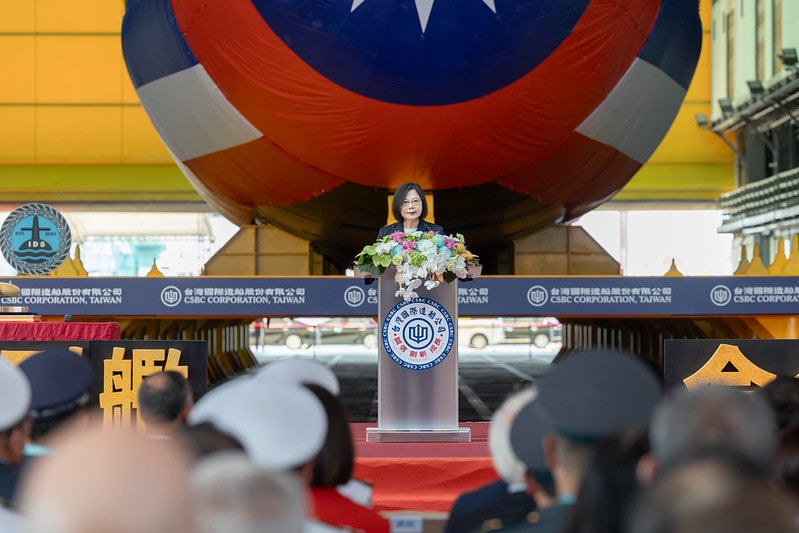Taiwan Launches First Ever Domestically Built Submarine
In the southern Taiwanese city of Kaohsiung on the 28 September, President Tsai Ing-Wen of Taiwan christened the “Haikun” submarine (711) at a CSBC Corporation’s Kaohsiung shipyard. The first domestically-built submarine for the island nation, and the fruit of Tsai’s two terms in office pushing for defense modernization. “History will remember this day.” The President said.
The push for a domestically-produced submarine began in force as a memorandum signed on 21 March 2017, and according to reports, benefited from a multitude of Western and Western-aligned foreign contractors providing critical subsystems. This collaborative effort allowed the Taiwanese to rapidly develop their submarine technology in response to their deteriorating security situation.
The ship weighs in at 2,500 metric tons, at 70 metres long and 8 metres beam. She has been outfitted with 6 torpedo tubes and magazine of 18, carrying Mk48 1700kg torpedoes and UGM-84 anti-ship missiles, the boat is without a doubt capable of inducing heavy damage onto unsuspecting targets.
Taiwan’s current four submarine fleet consists of two World War 2 vintage Tench-class submarines, upgraded to the Greater Underwater Propulsion Power Program (GUPPY) standard, and two Chien Lung-class boats purchased from the Netherlands from the 1980s. All four boats are considered obsolete, especially against an adversary as advanced as China, and ROCS Hai Shih holds the record for oldest serving submarine in the world.

The $1.5 Billion investment into this submarine, as well as plans for seven more, also indicates a slowly evolving perspective on what Taiwanese policymakers consider desirable, from head-on, conventional warfare with the outsized opponent, and purchases that enable it, such as the F-16V and M1 Abrams; towards a more asymmetric style of war favoured by shore batteries, minelayers and now submarines spearheaded by the current administration. Deploying mines around ports and having submarines on patrol counters Chinese marines in transit and their supply chains toward beachheads during a potential landing, vital for maintaining momentum. Taipei can thus make the initial phase of the war costly and the prospect of invasion unfavourable for Chinese decision makers
Despite the fact that both are neighbored by threatening powers, a crucial difference between Taiwan and Ukraine remains; the fact that Taiwan is an island, one that does not have easy outgoing access for refugees and incoming war materiel from its allies. As such, It remains unlikely that the submarine would be used in the shallow Taiwan strait less than 150m deep, but would rather be used in defending the shipping lanes north and south of the island, where heavy Chinese Navy elements will be deployed to blockade Taiwan in an invasion scenario. The boats can also give credible threat to Chinese carriers and landing fleets, influencing the Chinese admiralty in their potential decisions to reach out of the First Island Chain and engage allied relief forces.

In the event of outright war in the Pacific, the submarines can help tighten the First Island Chain in hybrid warfare, by maintaining the potential presence of Taiwanese submarines in the Bashi strait and Miyako Channel and coordinating with allied submarine forces, Taiwan can deter or deny Chinese military projection into the Pacific through the aforementioned bodies of water. With several boats at sea at any given time, this allows some of Taiwan’s deterrence to survive a Chinese first-strike scenario and buy time for the world to react.
The severity of the obsolescence of the Taiwanese submarine fleet and the already difficult process of obtaining foreign technologies against Chinese influence means it was decided that, the prototype hull, Haikun would not fitted with Air Independent Propulsion like similar foreign diesel-electric designs in order to “have something to work with first”, and would be reconsidered when the Haikun class enters mass production.

Haikun’s role as a prototype was called upon when commentators noted the presence of a “rough” texture on the hull and sail of the boat, as an apparent mark of the extremely rapid pace of development and construction “there’s no magic shortcuts, and this bears remembering.”, commented Alex Luck, a researcher on the Chinese military.
Admiral Huang Shuguang, leader of the Domestic Submarine Manufacturing Project (潛艦國造計畫), said that the Navy has budgetted for the pre-procurement evaluation of a second deep-submergence rescue vehicle (DSRV) that would expand upon the current fleet of one and a Memorandum of Understanding with the US Navy for rapid response in case of an underwater emergency.
“Haikun” translates to “Narwhal” in english, yet its inspiration lies not in the ocean but in the ancient text 《莊子,逍遙遊》, where Haikun is described as another form of the Kunpeng, a mythic bird that is the namesake for the Chinese Y-20 transport aircraft. The namesake creature was written too be massive, elusive, and unknowable, fitting for the submarine and its duties in the depths. Haikun will begin sea trials next April, and she is slated to enter the fleet by the end of 2024.

